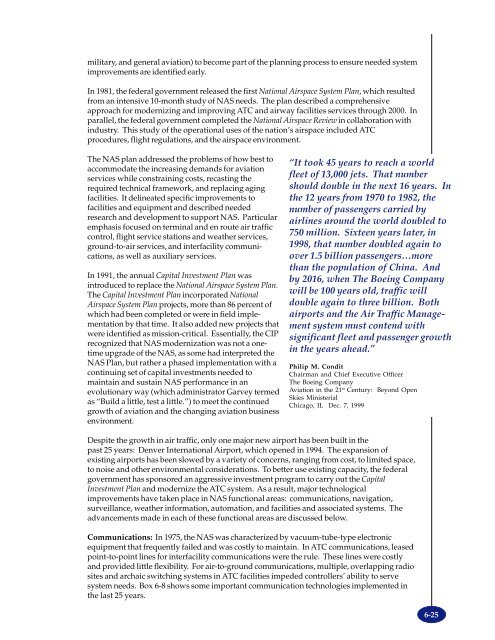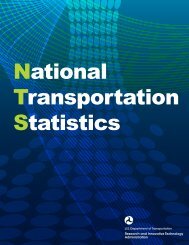TRANSPORTATION - BTS - Bureau of Transportation Statistics
TRANSPORTATION - BTS - Bureau of Transportation Statistics
TRANSPORTATION - BTS - Bureau of Transportation Statistics
You also want an ePaper? Increase the reach of your titles
YUMPU automatically turns print PDFs into web optimized ePapers that Google loves.
military, and general aviation) to become part <strong>of</strong> the planning process to ensure needed systemimprovements are identified early.In 1981, the federal government released the first National Airspace System Plan, which resultedfrom an intensive 10-month study <strong>of</strong> NAS needs. The plan described a comprehensiveapproach for modernizing and improving ATC and airway facilities services through 2000. Inparallel, the federal government completed the National Airspace Review in collaboration withindustry. This study <strong>of</strong> the operational uses <strong>of</strong> the nation’s airspace included ATCprocedures, flight regulations, and the airspace environment.The NAS plan addressed the problems <strong>of</strong> how best toaccommodate the increasing demands for aviationservices while constraining costs, recasting therequired technical framework, and replacing agingfacilities. It delineated specific improvements t<strong>of</strong>acilities and equipment and described neededresearch and development to support NAS. Particularemphasis focused on terminal and en route air trafficcontrol, flight service stations and weather services,ground-to-air services, and interfacility communications,as well as auxiliary services.In 1991, the annual Capital Investment Plan wasintroduced to replace the National Airspace System Plan.The Capital Investment Plan incorporated NationalAirspace System Plan projects, more than 86 percent <strong>of</strong>which had been completed or were in field implementationby that time. It also added new projects thatwere identified as mission-critical. Essentially, the CIPrecognized that NAS modernization was not a onetimeupgrade <strong>of</strong> the NAS, as some had interpreted theNAS Plan, but rather a phased implementation with acontinuing set <strong>of</strong> capital investments needed tomaintain and sustain NAS performance in anevolutionary way (which administrator Garvey termedas “Build a little, test a little.”) to meet the continuedgrowth <strong>of</strong> aviation and the changing aviation businessenvironment.“It took 45 years to reach a worldfleet <strong>of</strong> 13,000 jets. That numbershould double in the next 16 years. Inthe 12 years from 1970 to 1982, thenumber <strong>of</strong> passengers carried byairlines around the world doubled to750 million. Sixteen years later, in1998, that number doubled again toover 1.5 billion passengers…morethan the population <strong>of</strong> China. Andby 2016, when The Boeing Companywill be 100 years old, traffic willdouble again to three billion. Bothairports and the Air Traffic Managementsystem must contend withsignificant fleet and passenger growthin the years ahead.”Philip M. ConditChairman and Chief Executive OfficerThe Boeing CompanyAviation in the 21 st Century: Beyond OpenSkies MinisterialChicago, IL Dec. 7, 1999Despite the growth in air traffic, only one major new airport has been built in thepast 25 years: Denver International Airport, which opened in 1994. The expansion <strong>of</strong>existing airports has been slowed by a variety <strong>of</strong> concerns, ranging from cost, to limited space,to noise and other environmental considerations. To better use existing capacity, the federalgovernment has sponsored an aggressive investment program to carry out the CapitalInvestment Plan and modernize the ATC system. As a result, major technologicalimprovements have taken place in NAS functional areas: communications, navigation,surveillance, weather information, automation, and facilities and associated systems. Theadvancements made in each <strong>of</strong> these functional areas are discussed below.Communications: In 1975, the NAS was characterized by vacuum-tube-type electronicequipment that frequently failed and was costly to maintain. In ATC communications, leasedpoint-to-point lines for interfacility communications were the rule. These lines were costlyand provided little flexibility. For air-to-ground communications, multiple, overlapping radiosites and archaic switching systems in ATC facilities impeded controllers’ ability to servesystem needs. Box 6-8 shows some important communication technologies implemented inthe last 25 years.6-25
















